Welcome back, Tolkien fans, to this examination of the Hobbit films. As a reminder, we’re revisiting this trilogy in preparation for Amazon’s upcoming “Lord of the Rings prequel series”.
In my last review, we pulled apart the first half of Desolation of Smaug. And yes, I am fully aware that some of my critiques of the overall trilogy have been that they are “too long and meandering”, and here I am, pulling a Jackson, and breaking up these reviews into several installments. I don’t know how to deal with that irony other than to say that analytical essays serve better when they are thorough, and Jackson & Co forced my hand when they turned an intimate 300 page novel into a 3-part epic film trilogy. I digress. Here’s what we know so far concerning Amazon’s LoTR prequel series…
- Christopher Tolkien has stepped down as literary executor of the Tolkien Estate. The estate, of course, contains all of JRR Tolkien’s original works and the characters within them including: The Lord of the Rings, the Hobbit, the Silmarillion, Unfinished Tales of Numenor, and many others.
- For the first time ever, a television studio (Amazon) has purchased the rights to the Tolkien legendarium.
- Amazon beat out Netflix to acquire a five season contract and will reportedly expect to spend close to $1 billion on the show.
- The show is expected to land somewhere around November of 2019.
- Sir Ian Mckellen expressed interest in playing Gandalf.
- The opening of the show is rumored to begin with a young Aragorn
- There are talks that the series will be shot on location in New Zealand.
- Peter Jackson is rumored to be somewhat involved with the new project, but confirmation remains unclear…
Now, that last bullet point gives me some pause. If you’ve been following my last few reviews then you are aware of the great conflict within me concerning Jackson’s last attempt at the Middle Earth Universe. I’ve made a plethora of critiques and suggestions concerning their structures and their styles, and have tried to highlight where the films succeed. Perhaps some of you felt and feel the same ubiquitous conflict as I have concerning their (The Hobbit Trilogy’s) existence. Or perhaps you’ve already made up your mind as to whether you hated them or loved them. For me, I came to realize what an overall blunder these films have amounted to as a whole when I bore witness to the next segment, where my last review left off in DoS.
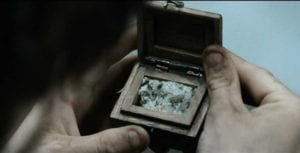
Boundless Barrel Blunders
So Bilbo and the dwarves are escaping Mirkwood. They all pile into barrels and Bilbo tells them to trust him…he pulls a lever and away they fly into the river. The segment that follows angers me so much as a Tolkien fan, Jackson fan, and really just a person who enjoys film in general.
Jackson & CO. wanted to make the Barrel sequence more exciting than the brief, inconsequential description (though far more logical and dependent on Bilbo’s cleverness) it is in the books. Okay, fine. You wanted to showcase how badass and capable your elven duo are. Okay, fine. But was there no way to use this 4 minute theme-park-ride as a way to give some depth to your characters or add some conflict into the story?
I mean, this is a scene where prisoners (dwarves) are escaping the clutches of an enemy (elves) who has scorned them, and are subsequently ambushed by a greater enemy (orcs) who have also been tracking said prisoners, and happen to hate their captors in kind. Feels like a set up to something interesting, no? But the segment manages to capture nothing of consequence at all, while simultaneously abandoning any semblance to a universe where things like gravity and physics play a part. It’s just one outrageous and tension-less barrel stunt after another, cut with max-level elves effortlessly slicing up low-level enemies.

Again, to be fair, it does start out in an interesting manner. The Elves close the gate and trap the dwarves, and Kili is shot by Bolg with an arrow during his attempt to open the gate. So you actually have this great dramatic set up with the dwarves being trapped, Kili being injured, and the orcs and elves entering a conflict. But then the tension is immediately deflated and all stakes and relationships take a back seat to another messy CGI set piece void of any real drama.
Once Kili opens the gate and falls into the barrel, the development of his injury, as well as the development of he and Tauriel’s relationship, is completely abandoned. They don’t even cut back to Kili, who is presumably just floating unconscious down the river.
In fact, nothing in the “barrel ride” sequence has any effect on any of the characters even in an abstract sense. We cannot tell how any of the characters feel about any of the other characters at all. It’s a mess. And all semblance of storytelling is put on hold to give way for Leggy and Tauriel to prance around and slay orcs. The audience is completely disoriented, and the characters (the elves, anyways) have completely lost site of why they are even running after these dwarves at all. With so much happening at once, wasn’t there a way to zero in on something that might have made this segment worthwhile? I mean, you can tell your audience a lot about your characters with little more than a look if there is a clear objective. Let’s discuss some possible alternatives:
- Center the entire conflict around getting the gate open. Stretch out the tension and give the dwarves a defensive position to void off both elves and orcs as the three races clash. This would nicely foreshadow the battle in the upcoming film. Each side might suffer some loss and we might get to see how that affects them and adds to their disdain for the other races…
- Center the barrel ride around trying to keep the wounded Kili from drowning.
- Give the orcs more interesting strategies for the dwarves to overcome other than just mindlessly hurling themselves at the barrels.
- Don’t have the dwarves and elves help each other. I mean seriously, Thorin kills an orc when he sees Legolas being overwhelmed with enemies. Wouldn’t it have been way more interesting for us if Thorin and the other dwarves were instead aiming their attacks at the elves too?
- Show some conflict with Tauriel, Legolas and the Dwarves, and more importantly inner conflict with Tauriel as they attempt to recapture the dwarves. Would it not be interesting to watch as Legolas and Tauriel attempt to stop the barrels from rushing down the river instead of just going out of their way to kill hordes of orcs? Each race, the elves, the dwarves, and the orcs would then take every opportunity to harm and help each other when the opportunity arose. Maybe there’s a part of the river that the elves know they’ll have a chance to slow the dwarves down and they need to get there before the barrels, but the orcs are in the way.
- Add onto the layers of your budding “romance” by having Tauriel’s main focus be Kili, and have the other dwarves not like it one bit. Why not put her in a position to stop one or several of these prisoners that are escaping, see? And maybe she pulls her punches and decides to let them go, because (we’ve been told) she supposedly has a soft spot for the dwarves. Then, you establish a deeper rift between elves and dwarves by having Fili, Kili’s older brother attack Tauriel when she gets close to the dwarves. Wouldn’t it be interesting to see Kili’s own brother whip an axe her way when the opportunity presented itself? Wouldn’t that present some conflict for our heroes to grapple with? Imagine if Fili actually wounded Tauriel considering the dwarves are laughably impressive at throwing melee weapons at moving targets. It’s not a mortal wound, but enough to prevent her from following the dwarves in that moment, and for the audience to get on Legolas’s side in that dwarves can be selfish and dangerous. And maybe Kili is upset with Fili for, you know, trying to kill the girl he’s crushing on? Plus and maybe Legolas helps Tauriel back to the stronghold and has an actual reason to want to keep her there and care for/about her. She’s wounded. But she’s still crushing so hard on the hot dwarf, that she persists despite her wounds, and despite the fact that her people hate dwarves. Wouldn’t that give us at least something to invest in and justify this four minute video game add? Imagine if there was some text that could point us to a feeling Legolas might have concerning Tauriel having an obvious interest in dwarves? Unless you count “he’s quite call for a dwarf.” Yuck.
Instead, the focus of the segment becomes about cool stunts that are as dependent on our suspension of disbelief as they are on Weta Digital. It’s spliced with disorienting gopro shots for effect as Legolas is bouncing around on heads, dwarves are freely tossing around melee weapons as though they were basketballs, and do I have to mention that open barrels filling up with water would get heavier and heavier and no longer be able to float? At one point after the conflict, Tauriel shoots an orc arrow headed for Legolas OUT OF THE SKY with an arrow of her own. I mean…what is happening? I’m genuinely fatigued in the worst kind of way after this segment. It becomes indefensible at this point. And it sucks having to be so pedantic about the logistics of stunts in a fantasy film…but with the absence of any story in this sequence, that’s all there is to analyze.
And I’m not saying that there aren’t cool things you can do with archery battles and you shouldn’t have cool action sequences in your movies. What would be the point of making an action/adventure film without them? No, I’m saying that when you design a scene around “what fun things can we do in order to burn minutes,” it just prolongs the story and cheapens all other action sequences that might involve a sense of risk or, you know, progress the story in any way. There are these great fantasy films made in the early 2000’s that really exhibit how to craft a well-done action sequence that builds and releases tension while advancing or foreshadowing something in the story… If only I could remember what those films were called.
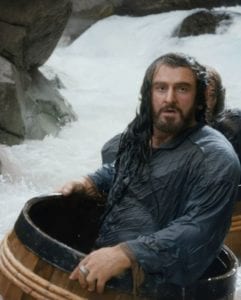
In Time, All Foul Scenes Come Forth
After the Barrel sequence, Legy and Tauriel capture an orc and bring him back to be questioned by Thranduil. And there’s no going back from here, you see, because it’s at this point you realize that Mirkwood wasn’t just another stop for the company. Not like the Misty Mountains, or the house of Beorn, no. Here is where we fully begin to see the decision to turn these films into a trilogy take form, where the very integrity of the narrative is unquestionably compromised. Where new plots spring out of holes in the ground like dwarven women.
Now I’ve already gone into detail about how frustereatingly vapid Tauriel’s character is, so let’s talk about her story, her plotline, her motives (Kili, Kili, and Kili, respectfully). It begins with one small, melodramatic scene with our main elves and a random orc. It becomes the big call to action for our elven heroin: the boy she like is wounded. Gasp! In the scene, this orc captive exposes two major things to us:
- Kili has been poisoned by a morgul shaft.
- The world will burn because “his master” is returning.
Now in order to get Tauriel moving and involved in this story we have to contrive this dialogue where the orc tells us about Kili’s wound. There are a number of holes in this one single line of dialogue and it speaks as a microcosm to the whole of the trilogy:
“Not thirteen, not anymore. The young one, the black-haired archer. We stuck him with a morgul shaft. The poison’s in his blood. He’ll be choking on it soon.” —-some orc we don’t care about.
This whole thing is just…my glory. We have to unpack this.
When, let’s call him orc #1 says there’s not thirteen dwarves anymore, he implies that one of them is dead. But Kili is not dead, which he confirms in the second half of the line. There are still thirteen dwarves. So why did he say it? I mean it’s not even like he shot the dwarf himself and is proud of his kill. He didn’t shoot Kili, and Kili isn’t dead. Oh I know why this line exists! Because if the subject of Kili doesn’t come up, then Tauriel has no purpose in this story. That’s bad writing. Then there’s the manner of referring to Kili as the “archer,” even though Kili didn’t use a bow in that entire barrel segment. “Well the orcs had been following them for the entire length of the film”, you might say. Okay, but the audience doesn’t recognize this orc at all, so it just acts as lame expository manufacturing. The orc even says the line right to Tauriel and sneers, as if we’re all supposed to just place meaning onto it. The moment is shot as though this orc knows exactly who Kili is in relation to Tauriel and it treats the audience like complete dolts.
Not to mention Tauriel saw Kili getting shot, and then didn’t really do anything to make sure he was okay. Remember, it was way more important to behead all those random orcs than it was to progress the story. So how do they fix this and raise the stakes? They make up a completely non-canonical motive–a “Morgul shaft” that has poisoned the dwarf– and this acquired knowledge is what pulls Tauriel into the story. It’s just insulting.
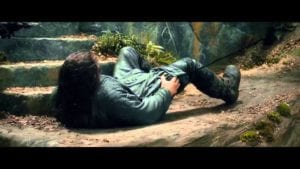
Then the orc monologues about his master serving “the One”, and, in so many words, burning the world. This is one thing I actually like as far as expository world-building goes, and ties into a widely accepted theory that Sauron was planning on using Smaug in his conquest of Middle Earth. It would not, after all, be the first time a Dark Lord enlists the help of a dragon to do his bidding. It’s a nice double meaning where the orc is speaking in reference to Sauron’s return, and Thranduil takes it to mean the enemy will plan to use Smaug in the wars to come. It’s interesting drama that might lead into some interesting discussions later on about battle strategies or the role of the Mirkwood elves in Middle Earth, but instead, the focus is about stupid Kili, and Thranduil brutally cuts off the orc’s head and nothing interesting becomes of it. The scene’s objective has been complete. Tauriel’s crush is in peril. Whatever.
You and Me Could Write a Bad Romance
This sense of fabrication follows Tauriel and Legolas for the entire rest of the film. He follows her. She assumed he would. So is she like, emotionally manipulating Legolas? Is she placing him in the mellon zone and just assuming that, like an elven lapdog, he’ll follow her on this adventure to save the boy she likes? I mean that’s the seed they’re planting, isn’t it? Or is Legolas just an idiot who can’t take a hint and like…he always creepily tails Tauriel on her adventures under the guise of “reinforcements”… Either way, I don’t recognize this once beloved character one bit.
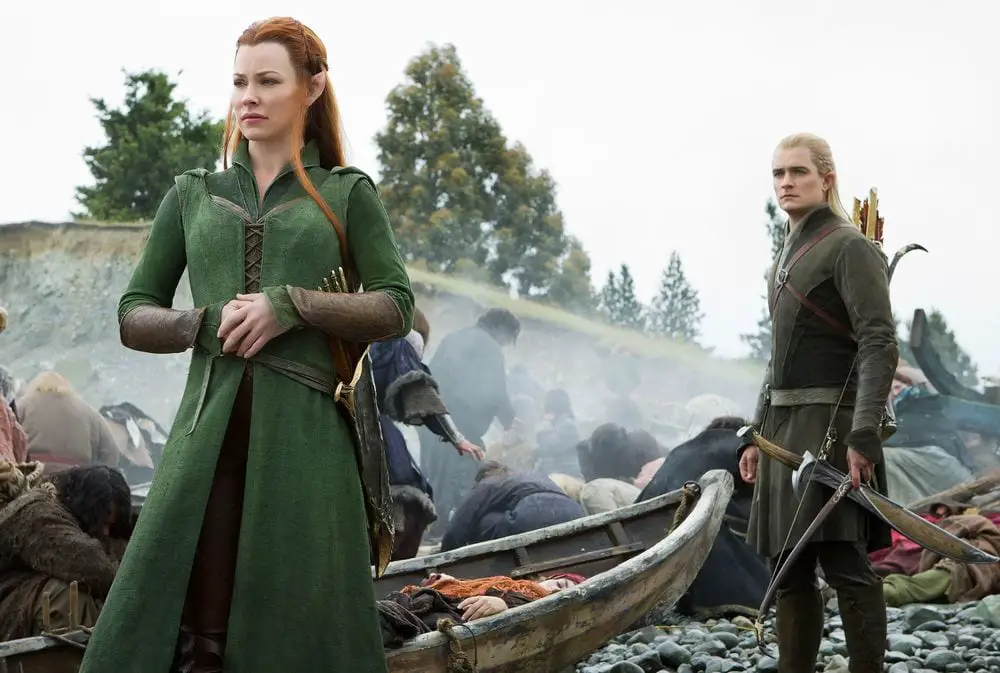
So they come up with this contrived adventure for our elves, and it’s clear they want this sense of “will they won’t they” to loom over the scenes. But then they go out of their way to not explore any aspect of the relationship dynamic in the film, however cliche and, well, un-Tolkienesque it may be. It’s something that exists over and over again in this film where an idea is presented and left completely unexplored. Instead of exploring character, they just bombard you with dialogue that is only meant to validate these characters being in the story at all. Tauriel saying “it is our fight” is just objectively not true in the context she’s speaking of. She left Mirkwood before the whole “your world will burn,” monologue happened so she isn’t aware of Sauron’s potential return, and she isn’t given any concrete motive like I suggested in the last portion of this analysis.
Also, the entire plot would completely fall apart at the seems if Legolas possessed even the slightest inkling for critical thinking, or had any kind of a spine or willingness to express how he feels. So In order for this entire story thread to continue, both characters have to obnoxiously go out of their way to not confront some very obvious feelings that the film wants you to project on them.
They can’t talk about her feelings for Kili and they can’t talk about his feelings for her, and this results in there never being an actual plan, so the audience cannot invest in their story. Imagine if Jackson and Co. actually took the time to build real visible prejudice towards dwarves that wasn’t just inserted as a punch line or to get from A to B? Imagine if they wanted Legolas to grow as a character organically? There’s a great quote from Robert McKee’s Award Winning novel on narrative structure entitled “Story”:
“True Character is revealed in the choices a human being makes under pressure—the greater the pressure, the deeper the revelation, the truer the choice to the character’s essential nature.”
So what is the pressure for Legolas and what is the decision he has to make? Well, the pressure is that he will lose Tauriel. Where they are going Whether he doesn’t want to lose her because he loves he or because he hates dwarves is not made clear. It could be both, but since neither are addressed, it’s more like neither. The decision he has to make is whether to follow her or not. And since Jackson & Co want him in the story but don’t want to mess with his character, He’s just sort of there.
All it would take is for Legolas to call her out and say “hey Tauriel, your speech isn’t convincing and I don’t believe for a second that you’re venturing out because of your elven ethics. I’m not here to follow you, I’m here to bring you back. I don’t want you to make a foolish decision and endanger our lives over some crush on a dwarf because I don’t like dwarves..I think you’re being stupid.” And him projecting his feelings for her onto the situation might actually lead to some emotional turmoil and or conflict.
But no. He says nothing. She just offers up a bunch of vague platitudes and he goes along with it. So you’re thinking “Okay, well maybe he’s just so deeply in love with Tauriel that he’s willing to put aside his prejudices, and she will be moved by this and their relationship will deepen and blossom into something relatively interesting and resolve into something emotionally rewarding.” Boy, would you be wrong.

DolGuldor, More Like DolGul-bore, Amiright?
I’ve touched upon this decision to reveal Sauron in the Hobbit (because it’s important) mostly as a choice that undermines the initial quest of Bilbo’s and the Dwarves (because it does), but it actually does even more harm than that. Revealing Sauron to Gandalf at the end of DoS also undermines the call to adventure within the Fellowship of the Ring. Using the context of these films, Gandalf is now FULLY AWARE that Sauron has returned to Middle Earth. He is also at the end of DoS, it is no longer a “whisper of a nameless fear” once you literally show the Dark Lord manifest himself in front of the wizard. So he’s just been, what, puttering around aimlessly for more than half a decade before he visits the Shire again?
Then Radagast shows up and you’re thinking there’s a point to his being there. Maybe there might be some consequences in order to show Sauron’s strength and offer a story arc to this walking punchline of a character.
- Maybe Radagast sacrifices himself in order to give Gandalf a chance to escape
- Maybe Sauron deceives them both and Radagast pays with his life
- Maybe Radagast has succumbed to the evil, and he’s there to deliver Mithrandir to the Dark Lord, foreshadowing that many good, noble beings (Saruman included) will succumb to the will of Sauron.
Now, if you are familiar with the extended edition, there is this entire segment omitted from the film featuring Thrain. It gives us some sense of risk and peril and at least reminds us that there are dwarves in this story. I mean it’s not that great because there is nothing for Thrain to really do since the Dol Guldur timeline is now out of order. Thrain has already given Gandalf the map and key, and we as an audience don’t know him or care about him. If Gandalf’s initial quest had been a search and rescue that Thorin was emotionally invested in (Gandalf is going to rescue his father) and that subsequently led to the reveal of Sauron, well at least that’s something. But that’s not what they did. To them, Thrain was just another new face in this film written as something for Gandalf to briefly interact with…so yeah, they cut Thrain. And then Radagast just leaves Gandalf alone to face Azog and Sauron, and the plot is not resolved. It’s a #cliffhanger. Fantastic.
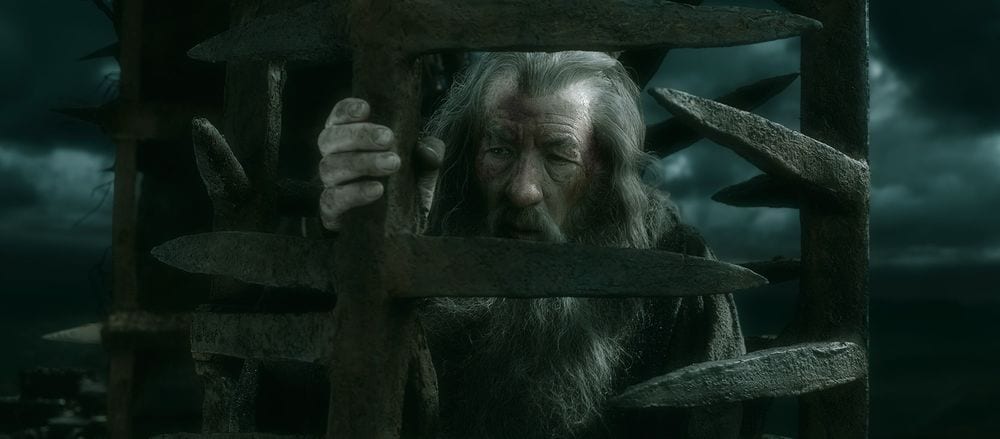
Turn Out Your Pockets
When the dwarves are found by Bard, the story finally gets back on track and we get my favorite Martin Freeman line in the entire film that always puts a smile on my face.
Bilbo: Bard, his name’s bard,
Bofer: How do you know?
Bilbo: Ah, I asked him.
It’s just…such a good line that effortlessly contributes to Bilbo’s character. Man, why wasn’t this film allowed to be the continuation of an intimate little tale about a Hobbit? Freeman is wonderful and when he’s caught between the dwarves squabbling, you almost feel like they want you to relate to these dozen dwarves as they build interpersonal relationships. This doesn’t last, however.
The barge segment can’t escape this film’s endemic tendency to phone it in and create more “that’ll do it” dialogue to push us through the plot. It’s the cringe-worthy exposition of orc #1 followed by his beheading, it’s the needless Beorn monologuing about how he hates dwarves, and then right before he disappears from the film having an unearned moment of “buuuuuuuut orcs are worse, let me help you out”, And it’s this exchange between Bard and Balin:
Balin: How Many bearings?
Bard: Three. Two girls and a boy.
Balin: And your wife, she’s a beauty I’d imagine.
Bard: Aye, she was.
Balin: Oh, I’m sorry, I didn’t mean to–
Dwalin: Ugh, enough with the niceties.
Yup, that’ll do it. It’s a lazy attempt to get the audience to like Bard immediately. It’s not enough that he’s a handsome, resourceful dude with a sharp tongue. His wife’s dead and he’s like such a good dad to his son Bain, and two daughters… ummm…Marcia and Jan? And, unbelievably, the nameless dead wife never comes up again and is completely meaningless to Bard’s character. Who was she? Is she important? What if she was an awful, abusive person? Or what if she was married to the Master of Lake Town and left him for the ruggedly handsome bowman, and then out of jealousy, the Master had her killed? Or what if Bard was responsible for his wife’s death and he’s been running from his guilt-ridden past ever since? Doesn’t matter.
I guess it’s part of their noble project to inject more females into the story by just writing dead women into everyone’s past who have nothing to do with the the narrative as a whole. I mean why not keep her alive long enough to be a casualty of Smaug’s attack? If you’re going to invent his wife just as a tool for us to connect with Bard, why not connect her death to the actual story you are telling? It would make us hate Smaug and empathize with Bard and his children.
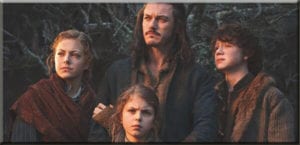
So Bard guides the party through rough waters, and we can all pretend the memory of his dead wife is guiding his hand. And then there’s this odd character moment with Gloin that leads us into an epic shot of the lonely mountain. Gloin is expected to turn out his pockets to pay Bard and he doesn’t want to, but like…why? Was there a setup for this? Is this a setup for something to come where Gloin is faced with a chance to be greedy but decides against it? Or is this just another of the numerous cases where Jackson & Co needed one of these interchangeable dwarves to say something that would lead them into the next moment of the story.
It’s hard to say, but Gloin takes in the site of the lonely mountain with the rest of his kin, and is suddenly moved to give up his monetary possessions. It could be a nice foreshadowing for the “dragon sickness” yet to come, but that’s probably just me desperately trying to give meaning to much of these odd dwarf moments that just sort of feel peppered into a script that no longer seems interested in the role they have to play in the tale.
Laketown
They eventually arrive in Laketown, and the segment is not without its charm. The fish gag is one I quite like, and it actually gives some tension and humor when they are being smuggled into the town. Actually, the decision to expand on Bard’s character overall is a good one. And Luke Evans is an excellent choice for the role. In the books, Bard is essentially a glorified extra, and now we have a chance to expand and care about him. But see, at this point in the film, with Gandalf unearthing a villian that is totally separate from the narrative, with Legolas running after a character completely non-existent in the Tolkien universe, with replacing Azog with Bolg and with the fact that absolutely no setups, payoffs, or character growth have yet to occur at any point in the film… I’m just tired.
And that’s a shame, because when the party gets to Lake-town, there are some really enjoyable moments here. The Lake-town theme is this gorgeous and energetic pirate shanty, the sets and costumes and culture seems really fleshed out with great care, and there are some fun character moments for our band of dwarves. There’s even a payoff when they are in the town: Kili’s wound causes him to fall over and make a bunch of noise so that the dwarves are caught stealing weapons from the armory. So that’s… something. Unfortunately though, Laketown is bogged down with yet another introduction scene to characters we don’t yet care about, to set up plot points that (spoiler alert) will not be resolved in the film. We’re an hour and a half through this film and there has yet to be any hint of theme or structure.
Stephen Fry and Ryan Gage have this goofy duo as The Master of Lake town and “Alfred”, his manservant. I’m very much a fan of both these actors, and fleshing out the societal tension in Laketown is a fine concept, but the performances are so cartoonish that they border on parody. I get what they were attempting with the overly corrupt politician making a foolish decision to entrust the dwarves, which would lead to a payoff when the town is destroyed, but there is so much screen time devoted to these characters and their machinations and it’s just more weight piled on top of this bloated narrative.
When the dwarves are caught and brought before the master it almost feels like a relief that Thorin and company are speaking about their quest. The cinematography in the segment is wonderful, the argument between Evens, Armitage, and Frye is one that elevates the drama and advances the story, but it amounts to nothing more than a bright spot in an otherwise lifeless and meandering script.
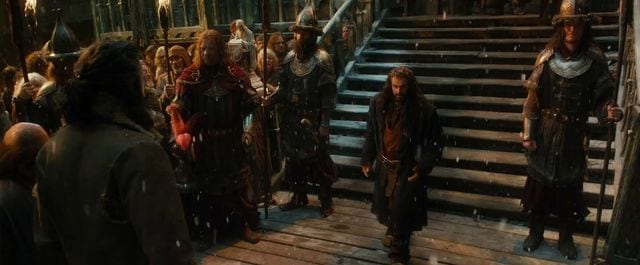
There’s also a missed opportunity with the Black Arrow legacy. You decided to make Bard a family man. Okay. But he’s father to 3 useless, uninteresting characters that offer nothing to the story, and don’t seem to have any relationship dynamic among themselves to speak of. That’s both unbalanced and boring. Why not give the kids something to do other than be in the way? Bard possesses every good quality in a man you could possibly want, and his kids have no qualities whatsoever.
Why not balance the fact that Bard is a good father with the fact that he’s afraid of his ancestor Girian’s legacy? Maybe Bard is an over-protective skeptic, and his son is the one who hides the black arrow in the house. Let it be Bard silencing Bain when the subject of Girian and the windlance comes up, instead of shoveling off a line with significance to Dwalin. That whole story should be told by Bain and re-affirmed by his sisters, and Bard should be silencing them. Proud men hiding from their destiny and projecting their fear onto others is a pretty universal theme explored by Tolkien, isn’t it? Maybe his son is the one who gives Bard the courage to fight Smaug, maybe his youngest daughter helps him to trust the dwarves, maybe his eldest helps him stand up to the Master and become the new Lord of Laketown the way his ancestor was Lord of Dale. Anything resembling character growth and dynamics would suffice, really.
But no. Nothing. It’s just so hard to comprehend that these are the same screenwriters who humanized Boromir in such an effective way.
Lovely Titles
Let’s talk about Smaug. Much like he was in the film, he’s merely an afterthought in this analysis. Zing.
From the first few moments of the prologue, we’ve been building up to when the dwarves would enter Erebor, and Bilbo would sneak into the halls and steal the Arkenstone away from the dragon. We had only seen pictures of the fire drake, we knew that Benedict Cummerbund was going to voice the beast, so fans of BBC’s Sherlock got an added nerdgasm during the hype, and we all couldn’t wait to see what was in store.
Smaug’s introduction turns out to be the most exciting part of the entire trilogy. The scene between he and Bilbo is fantastic and theatrical, the CGI looks incredible, the sound design is mouthwatering, the performances given by Freeman and Cumberbatch are exciting and honest, and you start to remember that this film is based on a masterpiece. The Arkenstone is within the hobbit’s grasp, the dwarves have reached their home, but there’s still the matter of the dragon to deal with, right? So what better way to wrap up this emotionally weightless film than with another exhausting, mindless action sequence!
This decision goes back to insisting on giving weight to Tauriel, Legolas, and Kili’s plot. The dwarven company now splits up in order to make us care about what happens to Laketown (because innocent people being incinerated by dragon fire isn’t enough), but now we have to delay the potentially exciting climax in order to give progression to the most thrilling romance ever told. But again the script avoids all tension between elves and dwarves because orcs are there and they’re worse, GET IT?
But why are the orcs even going after Kili and Bofer and Oin? I thought the orcs were hunting the company in order to stop Thorin from entering the mountain? Why isn’t that addressed? Why not create a moment where the orcs actually achieve something instead of more mindless hack-and-slash action where the orcs have no objective other than to scare children and get killed by Legolas? Have them kidnap Bard’s son or daughter. Have them beat one of the dwarves into submission in an effort to attain Thorin’s whereabouts. Have something of consequence happen that advances the story besides Kili being healed and holding hands with Tauriel, and Legolas developing a pointless rivalry with a CGI orc. This garbage now becomes the focal point of the story.
They shamelessly recycle visual cues and devices from the Lord of the Rings, they forcefully add new context to Legolas whose literary arc is already perfect the way it is, and they offer no real emotional substance to any of the dwarves present.
The last scene of this entire segment is of Legolas riding a CGI horse to pursue a villain he’s still yet to have ever spoken a word to. Fili, Oin, and Bofur have not grown or regressed as characters in any way, Tauriel and Kili’s relationship is weightless because it never faces any amount of real adversity, and worst of all, there is not even romantic payoff. The only thing more insulting than cramming an added love story down our throats is to make one that is completely void of passion. Jackson & Co have the gall to drown the Hobbit narrative in fluff to where it’s neigh unrecognizable, but they don’t have the gumption—no, the courtesy– to even make it interesting? Awesome.
Say what you will about the heedless subversion and deconstructions in the new Star Wars trilogy, but at least the story developments are interesting and nuanced. The Hobbit is just a mess and these films are not withstanding the test of even minimal time.
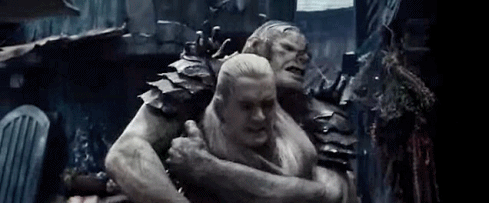
“So wait, what’s happening with Smaug?” I told you, he’s a footnote.
Okay, the dwarves have charged in to fight him. They run around him. They bounce on forges. They throw fireworks at him. They get him to blow fire at them and are seemingly unaffected. They tie him up and stuff, stand on his nose and ride metal shields on rivers of lava and are again seemingly unaffected, and then they… build a big golden statue thing…? They waste the audience’s time and completely undermine Smaug’s potential as a threat. It’s another hyper-real CGI set piece that stops the story dead.
See, Smaug was already pissed off that Bilbo had come with Oakenshield, so you could have had him just flying off after a fantastic, tension-filled scene with Bilbo, and interrupt the Tauriel/ Kili orc attack mess that carries no weight with the destruction of Laketown. I mean, wasn’t there a way to get some measurement of emotional payoff in the third act of this film?
- Kill one of the many, many expendable dwarves you’ve barely developed in over 5 hours of screen time. Someone like Fili dying would prove to have some emotional weight to it since he elects to stay behind and protect his brother. See it’s called irony. You’ve taken the time to set something up…Smaug is very dangerous, and very cunning, and everyone is terrified of him. Thorin tells Kili, that even though he’s family, he has to stay behind because he’ll “slow them down.” Fili, out of love for his brother or resentment to his uncle or something, (I don’t really know the dynamics of their relationship or their past) elects to stay behind. Yet nothing of consequence, nothing even mildly interesting comes of this development. Fili doesn’t even seem to have a problem with letting some strange elf maiden get her hands all over his brother. Legolas has no issue with this fact either, mind you. He’s busy having some tension-less fight with some big orc whom, before this scene, he’s only had one brief altercation with. Why not give the elves and dwarves reason to quarrel, and due to said quarrel, it COSTS THEM SOMETHING. Wouldn’t that be a marvelous bit of drama to watch as both Thorin and Kili blame themselves for the death of Fili? I’m just baffled why anyone in their right mind would care to see how this non story would conclude itself.
- Kill Smaug. Be the thing your movie says it is. Oh my Goodness. It’s obvious isn’t it? Finish the frikkin movie. Resolve the thing that we came for. In a movie titled The Desolation of Smaug, why wouldn’t you show Smaug desolating things? You even set it up when the dwarves pass the remains of Dale where the past desolation occurs. I’m just honestly dumbfounded at this decision. It’s as if you went out to dinner and the check arrived before you got finish your meal. “Come back next time to see how it ends,” but I’m still HUNGRY. This was the worst artistic decision made by a major motion picture franchise since I don’t know when. Cliffhangers are expected when the title of the movie is advertised as “Part 1” of something like when the Harry Potter franchise ended on a reveal after there was an emotional climax. All this ending amounts to is one big eff-you to the fans, and worse, to the Tolkien brand. I know it’s not fair to put all the weight of the blame onto Jackson & Co, but someone has to be held responsible for this decision. Having a cliffhanger ending just shows that you found no narrative purpose to pull out if this portion of the Hobbit. And boy does it show. The only thing that would make this trilogy worse is if they just cold opened their next film and tacked on this ending without concerns of themes or tones or character development…but I’m sure that won’t happen.
So…
Nothing of consequence has happened or will happen to any character in this film. We have to wait for the story to develop, or culminate, or however you see it. It’s also frustrating because Smaug is initially presented with such care and his scenes are written with such earned tension, but then his role is diminished to a farcical, bumbling villain. It’s all par for the course though, I suppose. The formula of this film has been to introduce a character or relationship, barely touch upon emotional theme/character potential, put story on hold for mindless action sequence, repeat. Bilbo’s relationship with Thorin stays stagnant, a plethora of characters appear and then disappear, and none of the plots or emotional arcs are resolved. This is honestly infuriating. The decision to stray from the Hobbit narrative in a movie entitled the Hobbit is pig-headed and insulting. It’s poorly written fanfiction with a huge budget.
Cliff Hanging Around
It’s abundantly clear that, even with the suggestions I’ve made to augment the story structure, that these films should not have been a trilogy. I literally have to pay for another ticket just to see how this movie ends. I know that the film industry is exponentially drifting towards the “marvel-esque” formation of extended universes due to their success, and studios are imploding over their need for the next summer box office hit, but this formula is not the answer. There are some things in fictional universes that are left unexplored for a reason. Movies are now being penned with the soul intention of build hype for the next installment movie like some twisted two-and-a-half-hour trailer.
Everything is left suspended in the air like Gandalf in that cage awaiting his fate. Except we already know his fate, don’t we? There’s no cliff to hang on here, just a studio fully aware that you care about Gandalf so much that you’ll sit through a full length snooze-fest where he has a bland adventure with another bland wizard against an enemy we’ve already seen defeated. When you invent entire characters and plotlines in order to turn 2 movies into 3, when you create action sequences for the sake of action sequences, when you force old beloved characters into narratives they don’t belong in, when you introduce themes and setup narrative payoffs only to leave them unexplored and unfulfilled, you get what this amounts to: a bloated pile of nothing that you’re now invested into seeing how it concludes.
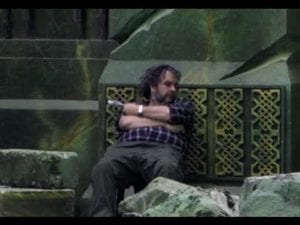
You see, when I first saw this film, I did rather enjoy it despite all it’s obvious structural issues. I think that was due to the fact that I was now placing all the emotional weight that wasn’t in this film onto the third installment, which I was sure would complete this tale, with all its faults, in a wonderful way. I just couldn’t wait to see how Jackson and Co. would conclude this story. I was hopefully awaiting the third film of this trilogy, There and Back Again would be a marvelous ending to this grand adventure.
Spoiler alert, it’s not. It’s actually the soul reason I’m so salty when it comes to these films, and am so jaded when the topic of Amazon’s new Tolkien series comes up. I care about Tolkien’s works more than I care about any piece of entertainment or literature in existence. I don’t want to see Legolas pout around and slay orcs for no reason, I don’t want to know about Bard’s dead wife, I don’t want to see Aragorn learn how to ride a horse, I don’t want to know if Gimli ever gets a date with Galadriel, I don’t want to know where Gandalf gets his supply of fireworks, I don’t want to watch Balin’s last stand in Moria, I don’t want to see any of it if it’s done with such brazen carelessness. I don’t want, to use an apt comparison, to see the one ring fall into the wrong hands when it comes to respecting Tolkien’s legacy. For now we can only hope that Amazon investing a billion dollars into a project means that they know how much these stories are worth.
Until then I can’t wait to rip Battle of the Five Armies into a million pieces, the same way it and DoS did to my favorite childhood novel. I hope this was as cathartic for you as it was for me and that you’ll join me next time for the final installment!


